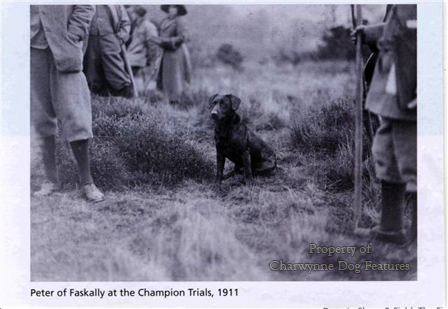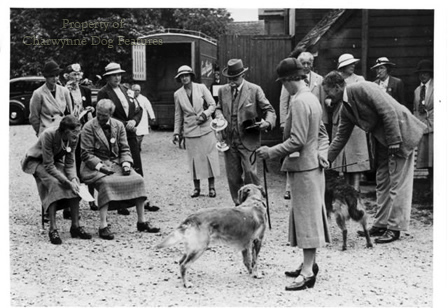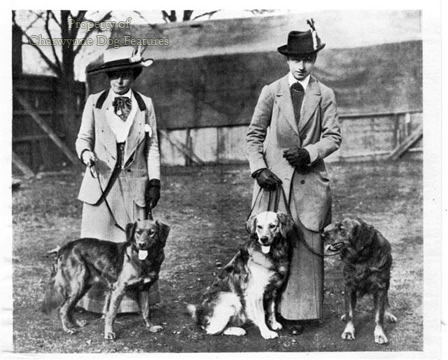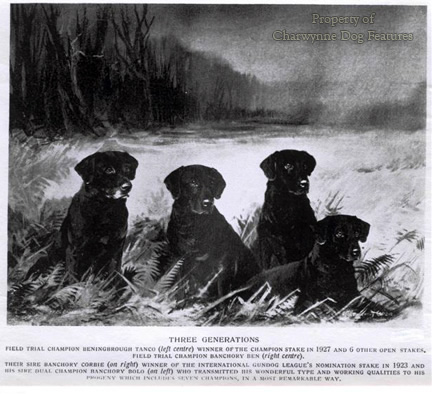231 Charm of Retrievers
THE CHARM OF THE RETRIEVERS
by David Hancock
 A descriptive noun usually comes quickly to mind when a dog fancier conjures up a mind image of a group of dogs. For me, the sighthounds have elegance, the mastiff group stoicism, the terriers tenacity, the scenthounds single-mindedness and the spaniels merriment. So many toydogs have a certain coquettishness about them. The bullterriers always seem to have a glint in their eye. The retrievers, as British as terriers, I always connect with charm. So many of them are simply delightful, captivating and easily attract admiration. Seeing the eternally waving tails of Golden Retrievers always gives me pleasure. There is a warmth about the Chesapeake Bay Retriever, it doesn't seem to bother with small matters. I judged a working test where they performed and some of the other breeds were concerned about the height of the river bank, until that is, a 'Chessie' arrived and dived a good eight feet out into the fast-flowing river without hesitation.
A descriptive noun usually comes quickly to mind when a dog fancier conjures up a mind image of a group of dogs. For me, the sighthounds have elegance, the mastiff group stoicism, the terriers tenacity, the scenthounds single-mindedness and the spaniels merriment. So many toydogs have a certain coquettishness about them. The bullterriers always seem to have a glint in their eye. The retrievers, as British as terriers, I always connect with charm. So many of them are simply delightful, captivating and easily attract admiration. Seeing the eternally waving tails of Golden Retrievers always gives me pleasure. There is a warmth about the Chesapeake Bay Retriever, it doesn't seem to bother with small matters. I judged a working test where they performed and some of the other breeds were concerned about the height of the river bank, until that is, a 'Chessie' arrived and dived a good eight feet out into the fast-flowing river without hesitation.
Sporting writers down the years have always found something nice to say about the retrievers. Stern taskmasters driven mad by the waywardness of cockers, the selective deafness of bassets and the wildness of hunt terriers have rarely rubbished the retrievers. Quite the reverse; their prose on this subject has frequently been inspired. And yet the field role of the working retriever is a demanding one. I don't agree with the distinguished gundog writer, Wilson Stephens, when he describes the task of retrieving shot game as "a simple act of porterage". The memory needed for marking falling game, the nosework required for game-finding and the softness of mouth to retrieve to hand calls for a variety of skills. Picking up in a galeforce wind or sitting in a freezing estuary on a December dawn is not a job for softees.
It is fair I believe to describe the Labrador Retriever as the sporting dog of the twentieth century, since their development as a breed, popularity and prowess is undisputed. It is probably just as fair to describe the Curly-coated Retriever as the oldest and most under-rated breed of retriever. Their qualities are well known to their owners but are usually untapped by the majority of shooting men. Yet there is something very masculine about the curly, they are a fussless breed and a very individual one, protected from 'mongrelisation' by their astrakhan coats. I once spent a happy day judging working tests just for this breed and found much to admire in their character.
The Flat-coated Retriever I have long admired and when I was younger mourned their absence from the shooting field. It has been good to see a renaissance of their working qualities. They were once every gamekeepers' first choice. Combining handsomeness with intelligence, they have never been spoiled by over-popularity. Writing in the last century, 'Idstone', who was a gundog authority in his day, described one with these words: "He was as black as a raven -- blue-black -- not a very large dog, but wide over the back and loins, with limbs like a lion, and a thick, glossy, long, silky coat which parted down the back, a long sagacious head, full of character, and clean as a setter's in the manner of coat. His ears were small, and so close to his head that they were hidden in his feathered neck. His eye was neither more nor less than a human one. I never saw a bad expression in it." An enchanting description, richly deserved.
James Wentworth-Day, a demanding dog-man if there ever was one, referred to a Flat-coat in these words: "But Black Bess...was my father's dog, a magnificent flat-coat who shone in the sun like a raven's wing, who walked the grass with the gait of a queen. She was all good looks, good breeding and good heart." These words came back to me firstly when watching the late Pat Chapman's 'Shargleam Blackcap' win Best in Show at Crufts some years ago, and again when seeing FTCh 'Werrion Redwing of Collyers' at work in the field. Here were two happy handsome dogs in contrasting circumstances, really 'selling' their breed.
Wentworth-Day also admired the character of the Chesapeake Bay Retriever, as these words illustrate: "Their impression of power is quite remarkable. They give one the feeling of immense resources of energy, of great reservoirs of knowledge, of tolerance of disposition, obstinacy of purpose, and tenacity of principle. They are responsive, and they have a lot of quiet good sense." They would certainly be my first choice as a wild-fowling companion. At the turn of the century, 'Wildfowler', a much respected gundog authority, spelled out the requirements for a successful wildfowling dog: "...the dog has to learn so many more things than other breeds of dogs. He must stay ready for flighting, remain still in a punt, he must never open under the strongest temptation, never jump up, never be excited, obey signs implicitly, hunt when told and keep to heel when ordered...be tender-mouthed, very keen-nosed, strong-constitutioned, plucky, swim for ever, and stand hard winters with equanimity. A dog who does all these things well clearly is a valuable dog". Clearly! List the dogs you would prefer not to share a punt with! 
But whether wildfowling or winning the hearts of the dog-owning community, the Labrador is the retriever most people choose. In 1912 281 were registered, in 1922 916, and by the 1950s there were 4,000 registered with the KC each year. In recent years their popularity has known no bounds: 25,000 a year in the early 1990s and over 29,000 in 1994. Being the nation's most popular breed has not been all joy but their wide use outside the show ring indicates their versatility and skill. I have used them as tracking dogs in the jungle and overseen their use as explosives detectors and body seekers; they have rarely disappointed me. This is a breed that wants to work and yet so many are purchased by people who just want a pet and seem unembarrassed by a bored unhappy dog.
In the shooting field the Lab rules the roost. In 1908, of the 106 dogs entered for field trials, sixty two were Flat-coats, thirty nine Labradors, three curlies and two were inter-bred retrievers. The Flat-coats won 2 firsts, 5 seconds, 8 thirds and 3 fourths; the Labradors won 6 firsts, 2 seconds, one third and one fourth. Three years later, the Flat-coats won 2 firsts, 5 seconds, one third and 2 fourths; Labradors won 13 firsts, 11 seconds, 13 thirds and 6 fourths. Two years after that, Labradors won 20 firsts, 17 seconds, 19 thirds and 10 fourths, whereas Flatcoats won one first, 2 seconds, 3 thirds and one fourth, a quite astonishing performance in a field where change is not welcome.
Retrievers as recognised breeds of sporting dog are only around one hundred and forty years old, probably starting in the 1850s as a wavy-coated dog, allegedly from a cross between the Newfoundland dog and the setter. Curly-coated water dogs did of course precede them across most of the main European countries. There is an illustration in 'The Sketch Book of Jean de Tournes', published in 1556, of 'The Great Water Dogge', a big black shaggy-headed dog swimming out to retrieve a duck from a lake. Three centuries later, the celebrated 'Stonehenge' was writing: "The large black retriever is known by his resemblance to the small Newfoundland and Setter, between which two he is bred, and the forms of which he partakes of in nearly equal proportions." In these times when the Newfoundland, once called 'The Great Retriever', is bred to look like a mountain dog, it is easy to overlook their true heritage.
In his valuable work, 'Dog Breaking' of 1876, the renowned General Hutchinson gave this opinion: "...it is usually allowed that, as a general rule, the best land retrievers are bred from a cross between the Setter and the Newfoundland, or the strong Spaniel and the Newfoundland...the far slighter dog reared by the settlers on the coast, a dog that is quite as fond of water as of land..." This 'far slighter dog' indicates the variety of type found in the early imports from Newfoundland. Studying the Yellow Labradors going through a working test a few years ago, their action in pursuit of ground scent reminded me of another breed at work and I couldn't place it. Then it dawned on me that they were working the cover exactly as a foxhound would.
I understand that foxhound blood was used with Labradors in the north of England in the 1940s, although ostensibly to improve appearance. The head of the Labrador is more houndlike than the other retriever breeds. I have heard it argued that the higher tail carriage of the hound is often accompanied by an un-Labradorlike aggression. In his 'The Dog' of 1872, the knowledgeable 'Idstone' wrote that the smooth-coated retriever "tracked his game like a Bloodhound". 'Stonehenge' writing in 1860 referred to a famous retriever of Lord Fitzwilliam which was by a bloodhound out of a mastiff. I see many houndlike actions in the Labrador at work in the field, perhaps because I am now looking out for it. But it is interesting that a decade ago, a Swedish breeder reported mismarked pups in a purebred litter; some being black with fawn, some with brindling and some chocolate and tan.
The popularity of the Golden and Labrador retrievers however has not been without its drawbacks. We seem to be losing that appealing 'soft' eye in the Labrador and the striking red-gold coat of the Golden. I see more overweight Labradors than any other breed and far too many with untypical, often Rottweiler-like heads with 'hard' eyes. There are worrying frequencies of unacceptable temperament in both these distinguished breeds. I am disappointed in the quality of coat on specimens I see at shows. A dense waterproof coat is simply essential in such a breed. At Crufts last year the hind action and lack of drive in the Golden Retriever dogs was not a credit to the breed. The overall standard of the Labradors was disappointing, with some dogs not worthy of the day.
The 1995 Crufts critique for the Chesapeake Bay Retriever read: "For such a numerically small breed, I was disappointed to see such diversity in type...several heads were heavy, with thick lips and low-set rounded ears...Mnay exhibits lacked good front angulation..." I admire this breed and do hope it will be retained as a real worker. I think back to the worries of Wentworth-Day on this breed: "It will take many generations of stupid women in Bayswater and suede-footed young men in Kensington to ruin the character of this eminently sensible working dog. He has all the dignity, the native aristocracy, the quiet good sense and the instinctive judgement of the British working man...If you have two or three Chesapeakes in the kennel there will never be any disturbances in your shooting routine -- none of that hoity-toity flightiness of the Gordon Setter, the kiss-me-quick slobberings of the spaniel or the mental whimperings of the Golden Retriever. Do not imagine for a moment that I dislike any of these three excellent breeds of sporting dog. But I mourn for individuals among them. The show-bench and the drawing-room have made fools of them...I doubt if you could ever do that with the Chesapeake. He will probably bite someone finally, just as a protest and then walk out of the house, a dog in search of a man for a master."
This strongly-worded tribute to the Chesapeake Bay Retriever may not appeal to everyone but the sentiments apply to all the retriever breeds and should be heeded by all who love their particular breed and care about their spiritual happiness and well-being. The retriever breeds must be retained as working breeds and their conformation, character and commitment perpetuated with that in mind, ahead of rosette-winning and fashion of the day. These breeds were developed in a hard school and their precious physical and mental qualities handed on to us to be safeguarded in our lifetime as a matter of honour. We owe it to this charming and valuable group of breeds that those who come after us will respect our contribution to their best long-term interests. Such a contribution is richly deserved. Long live the retrievers!